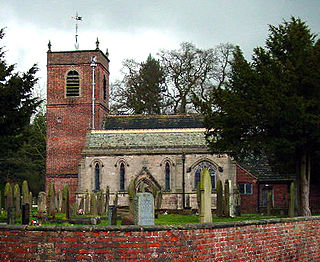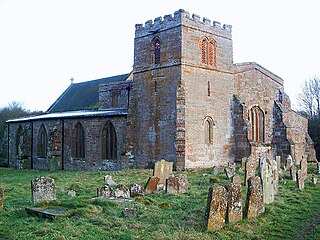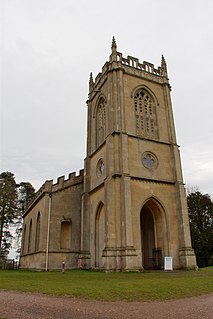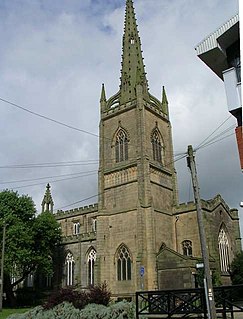
Hampton in Arden is a village and civil parish in the Metropolitan Borough of Solihull, in the West Midlands of England. Hampton in Arden was part of Warwickshire until the 1974 boundary changes. It lies within the Meriden Gap area of countryside between Solihull and Coventry. Hampton in Arden is a typical Arden village, but is now very much a commuter settlement for nearby Birmingham, Solihull and Coventry. In 1968 the central part of the village was designated a Conservation Area, which is an "area of special architectural or historic interest, the character or appearance of which it is desirable to preserve or enhance". Its population in the 2001 census was 1,787, increasing to 1,834 at the 2011 Census.
Thomas Rickman was an English architect and architectural antiquary who was a major figure in the Gothic Revival. He is particularly remembered for his Attempt to Discriminate the Styles of English Architecture (1817), which established the basic chronological classification and terminology that are still in widespread use for the different styles of English medieval ecclesiastical architecture.

St George's Church is in Everton, Liverpool, Merseyside, England. It is recorded in the National Heritage List for England as a designated Grade I listed building, and is the earliest of three churches in Liverpool built by John Cragg, who used many components in cast iron which were made at his Mersey Iron Foundry. It is an active Anglican parish church in the Diocese of Liverpool, the Liverpool archdeaconry, and the Liverpool North deanery.

St Michael's Church is a Church of England parish church in St Albans, Hertfordshire, England. Much of the building is late 10th or early 11th century, making it the most significant surviving Anglo-Saxon building in the county. It is located near the centre of Roman Verulamium to the west of the modern city.

St Nicholas Church is a Church of England parish church in Kenilworth, Warwickshire, England.
Richard Charles Hussey, often referred to as R. C. Hussey, was a British architect. He was in partnership with Thomas Rickman from 1835, whose practice he assumed in 1838 with the latter's failing health; Rickman died on 4 January 1841.

St Peter's Church is in the village of Swettenham, Cheshire, England. The church is recorded in the National Heritage List for England as a designated Grade II* listed building. It is an active Anglican parish church in the diocese of Chester, the archdeaconry of Macclesfield and the deanery of Congleton. Its benefice is combined with that of Marton, Siddington, Eaton and Hulme Walfield.

Ettington is a village and civil parish about 5.5 miles (9 km) south-east of Stratford-upon-Avon in Warwickshire, England. The 2011 Census recorded the parish's population as 1,171.

The Parish Church of Saint Peter ad Vincula, South Newington is the Church of England parish church of South Newington, a village about 5 miles (8 km) southwest of Banbury in Oxfordshire. The church is one of only 15 in England dedicated to St Peter ad Vincula, after the basilica of San Pietro in Vincoli in Rome.

St Michael's Church is an Anglican church in the village of St Michael's on Wyre, Lancashire, England. It is a typical late Medieval church and has been designated by English Heritage as a Grade I listed building. It is an active parish church in the Diocese of Blackburn and the archdeaconry of Lancaster.

St Peter's Church is a redundant Anglican church standing in an isolated position in the civil parish of Wolfhampcote, Warwickshire, England. Since 1960 the church and its attached mausoleum have been recorded in the National Heritage List for England as a designated Grade II* listed building, and are now under the care of the Churches Conservation Trust. The church stands in a field which contains a number of mounds. These are partly the remains of the medieval village initially served by the church, which has been deserted village for centuries, partly from disused canal workings, and partly from the remains of a redundant railway line.

St Mary Magdalene's Church is a former Anglican church in the grounds of Croome Court, at Croome D'Abitot, Worcestershire, England. It is recorded in the National Heritage List for England as a designated Grade I listed building, and is under the care of The Churches Conservation Trust. It stands on a hill in Croome Park. Commenting on the church, the architectural historian Nikolaus Pevsner stated it is "one of the most serious of the Early Gothic Revival outside, one of the most elegant inside".

St Denys' Church is a redundant Anglican church in the village of Little Barford, Bedfordshire, England. It is recorded in the National Heritage List for England as a designated Grade II* listed building, and is under the care of the Churches Conservation Trust.

Seckington is a village and civil parish in North Warwickshire, about 4 miles (6 km) northeast of Tamworth, Staffordshire. The B4593 road between Tamworth and Appleby Magna runs through the parish, passing about 100 yards (91 m) north of the village.

The Church of St Nicholas is a Grade I listed parish church in the village of Mavesyn Ridware, Staffordshire, England. The church is situated at the eastern end of the village approximately 370 m (1,210 ft) north of the River Trent and just to the north of the Gatehouse of the former ancient Manor House. Although medieval in origin the church was partly demolished in 1782 leaving only the north aisle and west tower remaining from the older structure. The church is one of only 12 Grade I listed buildings in Lichfield District. It is listed as such as it is a complete example of a late 18th-century church rebuilding including a very rare late 18th-century and early 19th-century conversion of a medieval aisle to the former church into a family chapel with neo-medieval fittings and monuments.

St Peter's Church is a redundant Anglican parish church in St Peter's Square, Preston, Lancashire, England. It is recorded in the National Heritage List for England as a designated Grade II* listed building. It was a Commissioners' church, having received a grant towards its construction from the Church Building Commission. In 1973 it became part of Preston Polytechnic, later the University of Central Lancashire.

St Silas' Church is in Preston New Road, Blackburn, Lancashire, England. It is an active Anglican parish church in the deanery of Blackburn with Darwen, the archdeaconry of Blackburn, and the diocese of Blackburn. The church is recorded in the National Heritage List for England as a designated Grade II* listed building.

St Peter's Church is in Bank Street, Darwen, Lancashire, England. It is an active Anglican parish church in the deanery of Blackburn with Darwen, the archdeaconry of Blackburn, and the diocese of Blackburn. The church is recorded in the National Heritage List for England as a designated Grade II* listed building. It was a Commissioners' church, having received a grant towards its construction from the Church Building Commission.

St Mary's Church is a Grade I listed parish church in the Church of England in Kersey, Suffolk.

The Church of St Peter ad Vincula is the Church of England parish church for the village of Combe Martin in North Devon in the UK. Possibly built on the site of a Saxon church, construction of the present building began in the 13th-century with additions in the 15th-century and later. It has been a Grade I listed building since 1965. The church comes under the Diocese of Exeter. Pevsner describes the church as "One of the best in the neighbourhood." The church is one of only 15 in England dedicated to St Peter ad Vincula, after the basilica of San Pietro in Vincoli in Rome.




















